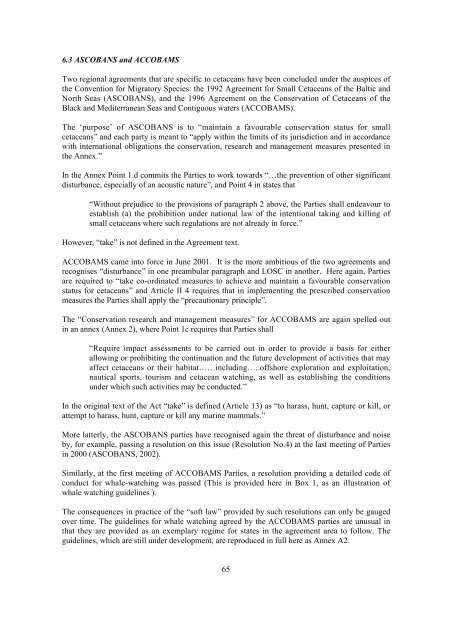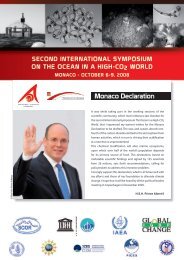Oceans of noise - Whale and Dolphin Conservation Society
Oceans of noise - Whale and Dolphin Conservation Society
Oceans of noise - Whale and Dolphin Conservation Society
- No tags were found...
Create successful ePaper yourself
Turn your PDF publications into a flip-book with our unique Google optimized e-Paper software.
6.3 ASCOBANS <strong>and</strong> ACCOBAMSTwo regional agreements that are specific to cetaceans have been concluded under the auspices <strong>of</strong>the Convention for Migratory Species: the 1992 Agreement for Small Cetaceans <strong>of</strong> the Baltic <strong>and</strong>North Seas (ASCOBANS), <strong>and</strong> the 1996 Agreement on the <strong>Conservation</strong> <strong>of</strong> Cetaceans <strong>of</strong> theBlack <strong>and</strong> Mediterranean Seas <strong>and</strong> Contiguous waters (ACCOBAMS).The ‘purpose’ <strong>of</strong> ASCOBANS is to “maintain a favourable conservation status for smallcetaceans” <strong>and</strong> each party is meant to “apply within the limits <strong>of</strong> its jurisdiction <strong>and</strong> in accordancewith international obligations the conservation, research <strong>and</strong> management measures presented inthe Annex.”In the Annex Point 1.d commits the Parties to work towards “…the prevention <strong>of</strong> other significantdisturbance, especially <strong>of</strong> an acoustic nature”, <strong>and</strong> Point 4 in states that“Without prejudice to the provisions <strong>of</strong> paragraph 2 above, the Parties shall endeavour toestablish (a) the prohibition under national law <strong>of</strong> the intentional taking <strong>and</strong> killing <strong>of</strong>small cetaceans where such regulations are not already in force.”However, “take” is not defined in the Agreement text.ACCOBAMS came into force in June 2001. It is the more ambitious <strong>of</strong> the two agreements <strong>and</strong>recognises “disturbance” in one preambular paragraph <strong>and</strong> LOSC in another. Here again, Partiesare required to “take co-ordinated measures to achieve <strong>and</strong> maintain a favourable conservationstatus for cetaceans” <strong>and</strong> Article II 4 requires that in implementing the prescribed conservationmeasures the Parties shall apply the “precautionary principle”.The “<strong>Conservation</strong> research <strong>and</strong> management measures” for ACCOBAMS are again spelled outin an annex (Annex 2), where Point 1c requires that Parties shall“Require impact assessments to be carried out in order to provide a basis for eitherallowing or prohibiting the continuation <strong>and</strong> the future development <strong>of</strong> activities that mayaffect cetaceans or their habitat……including…..<strong>of</strong>fshore exploration <strong>and</strong> exploitation,nautical sports, tourism <strong>and</strong> cetacean watching, as well as establishing the conditionsunder which such activities may be conducted.”In the original text <strong>of</strong> the Act “take” is defined (Article 13) as “to harass, hunt, capture or kill, orattempt to harass, hunt, capture or kill any marine mammals.”More latterly, the ASCOBANS parties have recognised again the threat <strong>of</strong> disturbance <strong>and</strong> <strong>noise</strong>by, for example, passing a resolution on this issue (Resolution No.4) at the last meeting <strong>of</strong> Partiesin 2000 (ASCOBANS, 2002).Similarly, at the first meeting <strong>of</strong> ACCOBAMS Parties, a resolution providing a detailed code <strong>of</strong>conduct for whale-watching was passed (This is provided here in Box 1, as an illustration <strong>of</strong>whale watching guidelines ).The consequences in practice <strong>of</strong> the “s<strong>of</strong>t law” provided by such resolutions can only be gaugedover time. The guidelines for whale watching agreed by the ACCOBAMS parties are unusual inthat they are provided as an exemplary regime for states in the agreement area to follow. Theguidelines, which are still under development, are reproduced in full here as Annex A2.65




